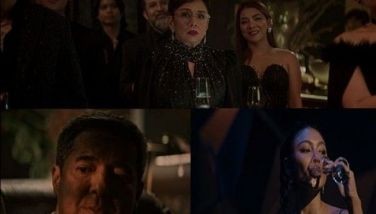The drama behind the red shoes
I can never understand other people’s obsession for shoes, especially since I am the type who manage to get by with very few — two pairs of leather (proudly local) and three inexpensive rubber shoes that I interchange so that my feet don’t smell (word of advice: Don’t wear the same pair of shoes every day if you don’t want your feet to stink).
If you ask me, shoes aren’t wise investments — unless you have plans of transforming into a caterpillar later in life.
In the case of Imelda Marcos’ 3,000 pairs of shoes, the couturier Joe Salazar had an explanation why the collection grew in number: For every terno he made for her came a matching pair of shoes. Surely, the former First Lady will have difficulty living down that image. Or could she be taking pride in that? After all, she became world famous for her shoe collection — never mind if that reputation is equated with extravagance.
From the time she became First Lady in 1966 (Ferdinand Marcos was elected President in November 1965), the Filipino public had always been fascinated with Imelda because of her statuesque beauty (and later, her odd public pronouncements about her visions for her City of Man). It is her huge shoe collection, however, that will leave an imprint in the minds of generations after the first EDSA revolution.
Young filmmakers today have already put together various documentaries about Imelda and a movie currently showing is pegged on her collection of shoes. The Red Shoes is not one of those remakes of the foreign film about a ballerina who has to choose between career and love.
Directed by Raul Jorolan, the film’s story begins when a young boy manages to filch a pair of Imelda’s red shoes in the middle of the confusion that followed shortly after the Marcos family fled Malacañang on the night of Feb. 25, 1986 — when people stormed the Palace and began an orgy of looting and vandalism.
The boy divides the pair between his mother (Liza Lorena) and a childhood sweetheart (she becomes Nikki Gil as an adult), who comes from a rich family. He then grows up as Marvin Agustin, a bank employee who always has trouble reconciling his accounts.
Nikki turns out to be the ideal girlfriend. She doesn’t let the economic disparity between her and Marvin get in the way. But the romance still turns sour eventually and they get separated. I won’t tell you, however, if they get reunited in the end.
This much I can say though: That romantic angle between Marvin and Nikki is what bogs down this film. For heaven’s sake, they are not John Lloyd Cruz and Bea Alonzo. Marvin and Nikki don’t have any chemistry between them and their love story almost ruins the film because it gets so boring in those parts.
Fortunately, writer James Ladioray basically has a solid story framework and director Jorolan manages to handle the rest of the scenes more than competently.
Interesting is the sub-story about Liza as Marvin’s mother. A manicurist by profession, she becomes so obsessed about reaching out to the spirit of Tirso Cruz III, her construction worker husband she presumed was among those who died when the interiors of the Manila Film Center collapsed in November 1981 and whose body was never found. She would cough out money and go to any medium or spirit questor who can contact her dead husband.
The sharper minds, however, can prove to be one step ahead and untangle this mystery in their heads. But even if you unravel the truth, there is still a surprising twist to it. I salute writer Ladioray for making his script tight. He meticulously worked out every detail of the story and that is so admirable. It’s a rare display of diligence in filmmaking.
Another side story features Tessie Tomas as a medium, who turns Imelda Marcos impersonator. She too becomes obsessed about acquiring the former First Lady’s red shoes in the possession of Liza and Nikki (they have one each, remember?) and will do anything to have the pair.
It’s another brilliant performance by Tessie and you notice that she somehow tries to veer away from her Meldita impressions to give her character in this film a fresh approach — and succeeds. Her co-stars also give impressive performances — like Liza, who — in spite of her being the mother — is able to realistically depict her financial and emotional dependence on her son. Of course, this scenario happens in real life — when the time comes when there already is a role reversal: The parents are the ones who have to toe the line and be obedient, especially if the offspring is the breadwinner. Even Iwa Moto gives an inspired performance as Nikki’s hospital co-worker (they are physical therapists) who causes trouble in paradise.
The best performances are actually delivered by Marvin and Nikki — despite the absence of chemistry between them. Individually, the acting jobs they display in the film are noteworthy.
The film as a whole (The Red Shoes was graded A by the Cinema Evaluation Board) is outstanding — again, except for the requisite romantic angle. Fortunately, it offers a lot more: Outstanding technical elements (the production design is the best) — plus creative writing and direction. I love the film’s ending — the concept and the execution.
The Red Shoes is also a refresher course on recent history. It stresses the fact why history should be taught in school — and should be read: So that we don’t repeat mistakes of the past! Never mind if history keeps repeating itself. With a film like this serving as reminder, we may be able to correct some errors along the way.
- Latest
- Trending


































